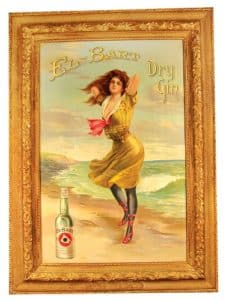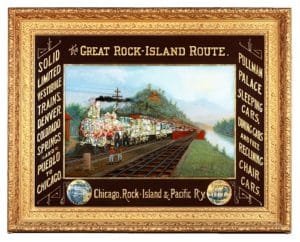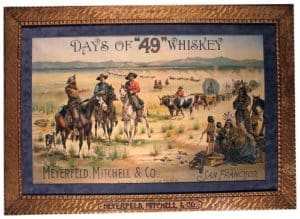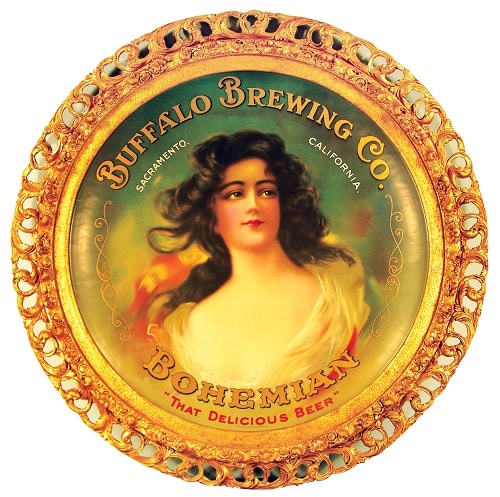By Michael Eckles
In the last ten years, antique advertising has become a very popular lot in auction arenas around the country.
The category is made up mostly of posters and signs but also includes calendars, banners, chargers and trays. Printed advertising as we know it has been around for hundreds of years, starting with simple signs denoting the trade practiced at a particular shop, to lengthy advertisements in newspapers and printed magazines, to a more “formatted” look devised by Benjamin Franklin with the addition of large print at the start of the written ad, to images with writing.
It is, however, examples produced from 1880 to 1925, when color lithography began and quickly gained in popularity, that are considered the most sought after and desirable among advanced collectors. Some of the specialized printing during that period included ink containing gold in the red and silver in the blue, producing some of the most colorful and vibrant images for advertising. And from then forward came colorful graphics printed on almost every surface available.
During the key segment of advertising history in the late 18th and early 20 centuries, all a company needed to get their name on the walls of general stores, cigar stores, saloons, drug stores, soda fountains, hardware stores, etc. was to hire an artist to portray their product in a colorful image, create the poster, and get the store owner to hang it on their walls.

Over the next ten years, the antique advertising category seemed to get lost in a mix of antiques dominated by furniture and glass. It wasn’t until 1989 when Peter Sidlow of Los Angeles, California sold his advertising collection at Noel Barrett’s auction house in New Hope, PA that people started taking notice (note: you can now find the poster from this auction for sale on many auction sites). Signs that were then selling for several hundred dollars sold for several thousand dollars at this auction.
Auction results for advertising in the coming years fluctuated up and down as it established its place in the world of antiques. A steady increase in the number of collectors appreciating the history, beauty and availability of these items also took shape during this time. The next significant auction that created a big stir was the George Cross collection offered in 2008 by Showtime Auction Services in Ann Arbor, Michigan. One example of a growing interest was realized by the sale of a Buffalo Brewing Tin Charger that had typically fetched $10,000 in the past but sold at this auction for $57,750.00 (including buyer’s premium). When prices like this are realized, word gets out quickly and interest peaks.
Since that auction in 2008, this category has exploded and it is not hard to find some examples in nearly every auction arena. The amount of collectors seems to be doubling and tripling nearly every year. This increase in demand has kept the prices up and they are continuing to rise.
The extraordinary color and graphics displayed in advertising signs creates a compelling esthetic value. Collectors are more apt to hang one on their wall in lieu of a piece of fine art.
Much of the most beautiful examples of the artwork involved are for alcohol, tobacco and firearms. These companies were the most successful at that time. Therefore, it was easier for them to afford the best artists and the finest printers in the U.S. For example, The Firearm’s industry hired such notable artists as Phillip R. Goodwin, Frank Stick, W.R. Leigh, Lynn Bogue Hunt, and N.C. Wyeth. Some of the original paintings from these artists are fetching hundreds of thousands of dollars at auction houses today. When searching for a specific advertising category, look for a specialized auction featuring your topic. Also, an auction company specializing in selling antique firearms or holding an antique firearms auction, for instance, will often have fine advertising examples from the genre in its many forms.

To add to the diversity of this category is the use of various different mediums used to print on. The most popular being paper, however, tin being less porous tended to make the ink more vibrant. Also used were paperboard, wood and Vitrolite. The rarest, and some would say the most beautiful signs were not printed at all. In contrast, they were hand painted on the reverse side of glass. It took a very talented artist to do this and there were not a lot of them produced.
Prominent lithographers were scattered throughout the East and Midwest. The largest were in New York, Philadelphia, Detroit and Chicago; however, the best lithographers congregated in Coshocton, Ohio. Due to the excellent quality of the signs, the companies thrived and business was booming. This caused a migration of good artists to move to Coshocton in hopes of getting their work accepted as the background for a whiskey, cigar or gun sign.
One product came in a close fourth to the big three. The signs, posters and calendars put out by makers of farm implements, wagons and equipment were spectacular. Some of the best color is found on paper or tin advertising a steam engine or thrasher. Because farm implement dealers were not in a position to carry a large inventory of equipment, the signs that hung in their store had to be able to attract the farmer’s attention.
Some other categories that are popular among collectors are drugs, soda, grocery, hardware, millinery, tools, cleansers, soap, shaving, furniture, seed, insurance, candy, stoves, railroad, cutlery, transportation, clocks and more.

Notes From the Author
My interest in antique advertising has spanned over 4 decades. In 2007, Cigar Aficionado magazine wrote a story about Showtime Auctions selling a cigar sign for $33,000. (Google “Signs of the Times Cigar Aficionado”) In that article, I made a statement.”I strongly believe,” Eckles said, “that I will sell these signs for over $100,000 in the next ten years.” In 2010, we sold a Rock Island Railroad reverse glass sign for $165,000, setting a record at that time for any piece of advertising ever sold at auction.
For anyone just now starting to get the collecting bug, I would suggest taking a serious look at the advertising category. I find it very intriguing that we now have color ads in newspapers and magazines. We have radio, television and the worldwide Internet saturated with advertising messages of all kinds. And yet, where can you go where you will not see a sign promoting some product that you really should buy. I think Antique Advertising will survive the test of time for years to come.
Donna and Bruce Weir of Indiana are promoters of a wonderful Antique Advertising Show in Indianapolis twice a year with a large assortment of signs, trays, calendars, tins and much more. Visit their website at www.indyadshow.com for more information.
The Antique Advertising Association of America, better known as Quad A, offers great information. For more about this organization visit www.pastimes.org. They publish 4 newsletters a year and have a convention for the members each summer.
Michael Eckles is co-owner with his wife, Lori, of Showtime Auction Services located in Woodhaven, MI. Showtime Auctions conducts 2 auctions a year specializing in investment grade antiques. Mike and Lori travel around the country 4 months out or each year searching for items that fit the criteria for their auction arena. You can visit their website at www.showtimeauctions.com for more information about the company or contact Michael at mike@showtimeauctions.com or call him at 951-453-2415. Lori can be reached at 313-715-4486.
-
- Assign a menu in Theme Options > Menus WooCommerce not Found





Related posts: